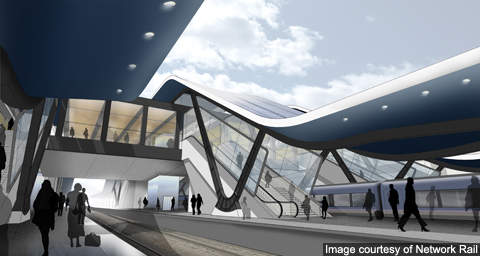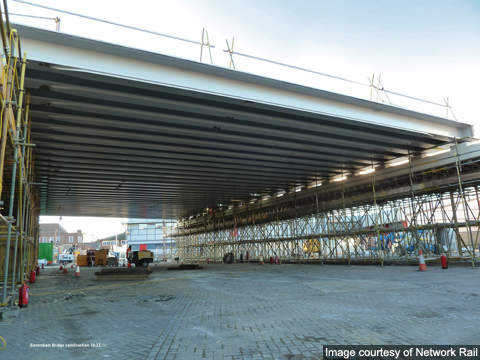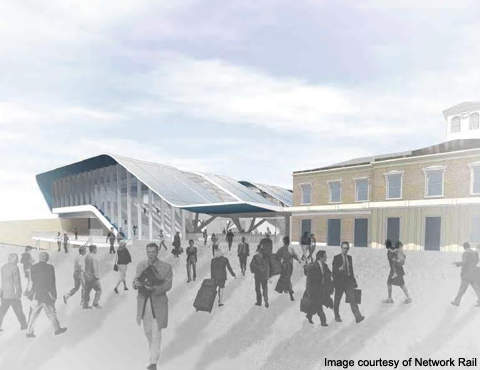Reading Railway Station is a major transport hub situated on the northern edge of Reading near to the River Thames. It is operated by three state-owned companies – First Great Western, South West Trains and CrossCountry. It is sponsored by ING Direct and the University of Reading.
The station is a major junction on the national rail system. Annual passenger traffic at the station has grown from 12.946m in 2002-2003 to 15.276m in 2011-2012. The increase in passenger and train traffic has resulted in congestion. Passengers have been suffering delays as trains have to wait outside the station until platforms are available. The annual passenger figure is expected to double by 2030.
A major redevelopment programme has been undertaken by Network Rail in association with Reading Borough Council to reduce congestion and meet the anticipated increase in traffic.
It involves construction of a bigger and more spacious station with five new platforms, two more entrances, a new passenger footbridge, extra lifts, escalators and more than 100 new customer information screens.
Estimated at £895m ($1.4bn), the project was approved by the Reading Borough Council in October 2010. Construction started in early 2011 and is scheduled to be completed by 2015.
History
Reading station was originally a single-sided station opened in March 1840. It served as a temporary western terminus station on the main line Great Western Railway.
As it began serving more trains, over a period, the single sided station was replaced by conventional up, down and relief platforms linked to a pedestrian subway. In the 1960s services were diverted from Reading Southern station to the newly constructed terminal platform 4a in the General Station. Another platform, 4b, was added to 4a in 1975 to serve longer trains operating between Reading and Gatwick Airport.
In the 1980s the station was made more spacious by construction of a concourse with a shopping arcade on the western end of the old Reading Southern station, which was linked to the platforms via a footbridge. In addition, facilities such as a multi-level car parking and a signal works building were constructed to the northern side of the station.
Layout
The station currently has 11 platforms serving both local and national services.
Platforms 1, 2 and 3 are west facing bay platforms used by CrossCountry to serve routes from Bournemouth to Birmingham. They are also used by local train services to Basingstoke, Newbury and Bedwyn.
Platforms 4, 5 and 6 are east facing bay platforms. Platforms 4 and 5 are used for fast services from Paddington to the West. Platform 6 is used for terminating local services to and from London Paddington.
The other platforms 4a and 4b are used by North Downs Line.
Platform 7, 8, 9 and 10 are used for local services operating between Paddington and Oxford.
Design and construction
Civil and enabling works began in the final quarter of 2010. The first stage of the project was completed in January 2011. It involved resignalling of 100 miles of railway line and transferring the entire signalling and control system to Didcot.
A new bridge at Caversham Road to make way for new tracks and platforms at the Reading Station was also erected during the period. Weighing 1,000t, the bridge is now ready to serve as a carrying track to new platforms on the northern side of the station.
The old signalling room has been demolished to make way for the new platforms and passenger footbridges.
A viaduct is being constructed to the west of the station to cut train delays and allow more number of trains to enter the station simultaneously.
All platforms of the station are being lengthened to create room for longer trains and upgraded with new platform canopies, better waiting room facilities as well as customer toilets and retail outlets.
Upgrades to platforms 1-6 and the platform 11 were completed in 2013. Platform 10 was upgraded in March 2014 and the remaining three platforms are scheduled for completion by the end of 2014.
A footbridge on Cow Lane and a tunnel under the railway for pedestrians are also a part of the redevelopment project.
Construction of a new flyover is scheduled for completion in early 2015.
Services
The station serves the main route of the Great Western Main Line. Operated by First Great Western, the rail line traverses from west of Paddington station and splits in the west of Reading station.
The other line connecting the station to Guildford and Gatwick airport is the North Downs Line. In addition, an electric suburban line operated by South West Trains links Reading to London Waterloo Station.
The station also serves as a stopping point on the routes to Birmingham, Northern England, Scotland, Winchester, Southampton and Bournemouth. All these routes run in the north-south direction and are operated by CrossCountry.




